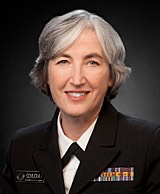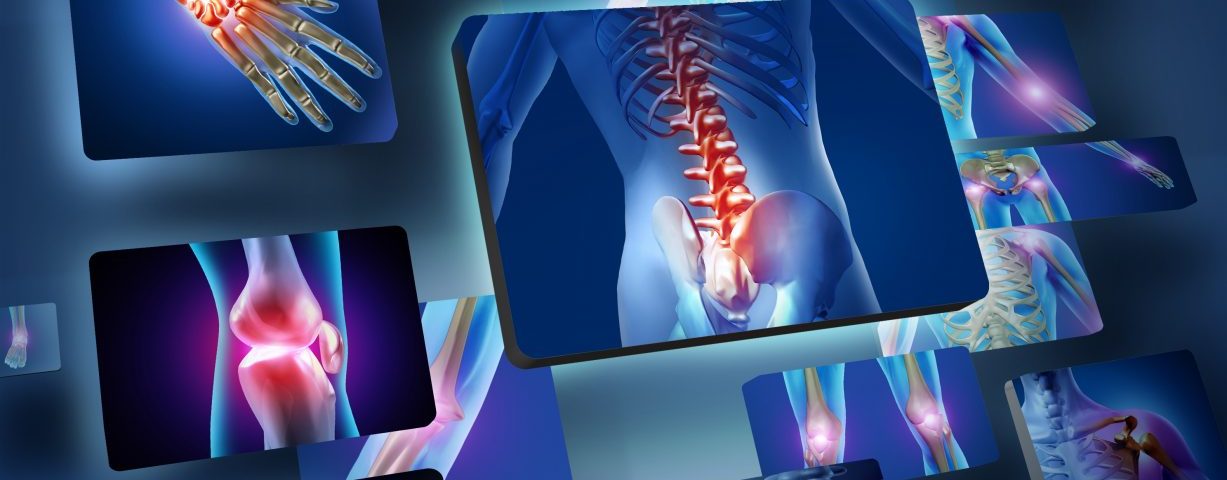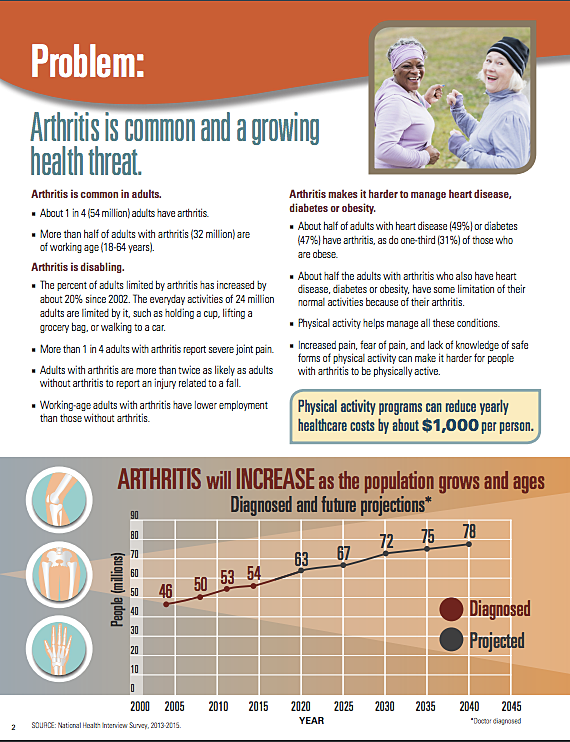According to the latest Centers for Disease Control (CDC) Vital Signs monthly report Arthritis in America, more than 54 million U.S. adults — one in four — are living with arthritis, and about half of them, 24 million, are limited in performing daily activities.
The report also states that the number of people limited by arthritic disease continues to grow, with arthritic disorders now among the leading causes of physical disability in the U.S.
While the term “arthritis” literally means joint inflammation, in the public health field it has acquired a broader meaning, and is used as a collective term for more than 100 rheumatic diseases and conditions that affect joints, surrounding tissues, and other connective tissues, including conditions like fibromyalgia and lupus.
 On March 7, CDC Vital Signs webcast a telebriefing and Q&A session discussing the Arthritis in America report, featuring CDC Acting Director Dr. Anne Schuchat, MD, along with CDC arthritis program epidemiologists Dr. Kamil Barbour and Dr. Chad Helmick.
On March 7, CDC Vital Signs webcast a telebriefing and Q&A session discussing the Arthritis in America report, featuring CDC Acting Director Dr. Anne Schuchat, MD, along with CDC arthritis program epidemiologists Dr. Kamil Barbour and Dr. Chad Helmick.
“Everyone knows someone with arthritis — family members, friends, and neighbors,” Schuchat said. “The news is this: Arthritis is at an all-time high. More than 54 million people report a diagnosis of it. Alarmingly, more people with arthritis are suffering from it.”
More people with lives that are limited
limSchuchat said that among adults with arthritis, the percentage whose lives are particularly limited has increased by about 20 percent since 2002, from about 36 percent then to 43 percent in 2015.
“We are seeing this increase independent of aging of the population,” she said.
“When I say limited,” Schuchat explained, “I mean that adults may not be able to kneel on the ground, hold a cup, lift a grocery bag, or walk to their car, [and] today’s Vital Signs report finds that 24 million adult American lives are limited because of their condition.”
According to a 2016 study published in the journal Arthritis & Rheumatology, with an aging U.S. population, by 2040 approximately 78 million (26 percent) of U.S. adults ages 18 or older are projected to have doctor-diagnosed arthritis.
And contrary to popular opinion, this is not an old person’s disease, Schuchat said, noting that about 60 percent of adults who have arthritis are younger than 65.
The bottom line, Schuchat said, is that the U.S. incidence of arthritis is at an all-time high and is negatively impacting the lives of millions of Americans.
The CDC’s acting director points to growing levels of obesity in the general population as among the likely co-factors, noting that while the CDC hasn’t done a complete analysis, they know that arthritis can be more severe in people suffering from obesity. The Vital Signs analysis indicated that nearly one in three obese adults also have arthritis, and about half of all adults with heart disease or diabetes have arthritis.
Common forms of arthritis
According to the CDC and the Arthritis Foundation, the most common form of arthritis in the U.S. is osteoarthritis, followed by gout, fibromyalgia, rheumatoid arthritis and lupus — the latter three known or believed to involve autoimmune activity.
Fibromyalgia is a long-term or chronic condition that may occur on its own or frequently co-occurs (in 25 to 65 percent of cases) with other rheumatic conditions, such as rheumatoid arthritis, systemic lupus erythematosus, and ankylosing spondylitis. The condition can affect muscles and soft tissues throughout the body. It can also cause depression or cognition problems (brain fog) such as confusion, forgetfulness, and difficulty concentrating.
The CDC says typical symptoms of arthritic diseases in general include pain or aching, stiffness, swelling, visible inflammation, and limited range of motion. Arthritis is a common cause of chronic pain. Approximately one-third of adults over age 45 with arthritis report anxiety or depression, and about three in 10 find movements like stooping, bending, or kneeling very difficult, with more than 20 percent of adults with arthritis finding it very difficult or impossible to walk three blocks.
African Americans and Hispanics with arthritis are more severely limited in their activities, according to statistics. Working-age adults with arthritis have lower employment than those without arthritis. And Schuchat says the direct medical costs to the U.S. economy for arthritis are estimated to be about $81 billion annually.
Stay physically active
However, the CDC says adults with arthritis can decrease pain and improve function by about 40 percent by keeping physically active.
“In the past, people with arthritis may have been told not to be active in fear of making their arthritis worse,” she said, “[but] it’s now proven that being physically active can be helpful, and there are ways to be active that can accommodate physical limitations from arthritis. We want people to know it’s best to address their arthritis before symptoms become more severe.”
“The Vital Signs report points to ways to ease arthritis pain without medicine,” Schuchat added. “Many adults with arthritis are prescribed opioids. However, there are safer options for arthritis associated pain to include exercise and more movement. The discomfort from arthritis leaves many people thinking they can’t do some exercise, but that’s exactly what they need to do.”
Adults can try swimming, walking, biking, or participating in physical activity programs in parks and recreation centers, YMCAs, and other organizations, she said.
Schuchat said the report highlights that proven disease management education programs where available (they currently reach only one in 10 people with arthritis) are a way to ease arthritis pain.
She said the CDC is calling on doctors and other healthcare providers to promote both physical activity and disease management education programs to adult patients with arthritis during patient visits, and also asking doctors and other providers to ask patients whether they are experiencing depression or anxiety, and to offer care, treatment, and links to services to those who are.
A transcript of the March 7 telebriefing is available at the CDC web site: http://www.cdc.gov/media.


